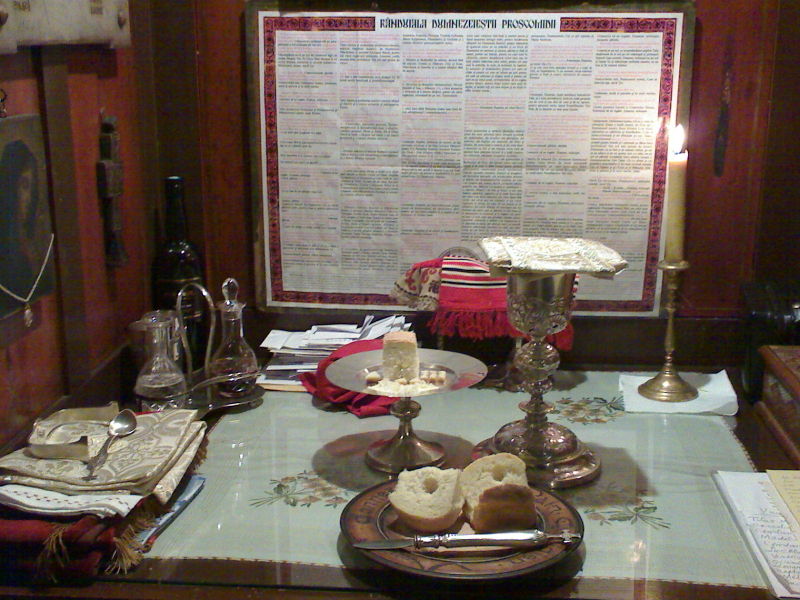 1. What is the Proskomidi?
1. What is the Proskomidi?
The Proskomidi is the first part of the Divine Liturgy during which the Priest prepares mystically the gifts necessary for the Eucharistic Sacrifice of the Liturgy. It is performed in a special place in the Holy Altar called the Oblation table‚ Proskomidi or Prothesis.
2. Why is the Proskomidi performed secretly?
The Proskomidi represents Christ before the start of his salvific mission in the world.[1]
3. What do the Gifts of Bread and Wine represent?
The gifts‚ according to St. Nicholas Cabasilas‚[2] are offered to God as a representation of human life […]. The people of the Old Testament were bringing as a sacrifice the first fruits of their crop. But these were foods common to all creatures. During the Liturgy we are bringing to God as gifts bread and wine as specific first fruits of human life. The bread and the wine represent food that is characteristic to man and not to other creatures‚ therefore they represent human life.
4. Why do the gifts have to represent our lives?
Because God is giving us life in exchange of this gifts‚ it is proper that our gifts be appropriate with it and be at least partially related with it. If what we receive is life what we offer should be also life.[3]
We offer Christ the bread and wine that are meant to build our earthly body so that He can give us in return the bread and wine transformed in His Body and in His Blood. In exchange for temporary life we receive life everlasting‚ the true Body and the true Blood of our Savior.
5. The bread and the wine are a symbol of the Communion of the faithful in the Church[4]
The Holy Liturgy is the service that by excellence illustrates the faithful as persons united in Faith in the Holy Church. The bread and the wine are the result of the gathering of the grinded grains of wheat or pressed grapes‚ respectively‚ representing therefore the union of the faithful in Church. This aspect is illustrated in one of the prayers from the Didachi of the 1’ Apostles (50-100 A.D.): “As this broken bread was scattered on the mountains and being gathered became one‚ so Your Church be gathered from the ends of the earth into Your Kingdom”
The bread and the wine are therefore a symbol of the Church‚ their offering during the Liturgy represents a sacrifice offered by the Church and in the same time a sacrifice of the Church itself.
However it is also necessary that together with the gifts we bring to the altar for the Holy Sacrifice to also offer to God the cleanness of our heart‚ our thoughts‚ our deeds and all our life‚ so they May all be sanctified in Jesus Christ our Lord.[5]
6. How is the Proskomidi performed?
Vested in all the Vestments the priest starts the Proskomidi with the blessing proceeded by three prostrations. Then he takes the Prosphoron in one hand and the spear in the other and blesses the seal on the Propsphoron with it. The seal was imprinted on the read. And contains the monogram of Jesus Christ IX XC and the word NI KA‚ meaning Jesus Christ conquers. After this the priest carves with the spear the 4 parts of the seal and takes out a rectangular piece that he puts on the diskos. This is the Amnos‚ or the Lamb that represents Christ on the Diskos. During the Liturgy the Amnos will be transformed in the Body of Christ. The Amnos is then divided (not entirely) into 4 pieces‚ cutting crosswise with the Spear. After this the priest carves out another triangular piece for the Mother of God that He puts at the right of the Lamb. Then he carves out 9 triangular pieces for the nine hosts of saints that he arranges at the left side of the Lamb. Then he takes out the pieces for the faithful that he orders in two piles under the Lamb for the Living (The Militant Church) and the Departed (The Triumphant Church)‚ while commemorating their names from the commemorating lists. Then after piercing the lamb with the spear the priest pours into the Chalice wine and water. The gifts are now covered with the Star and the Covers‚ incensed and blessed.
7. What does the Proskomidi represent?[6]
The Proskomidi represents on one hand the events related with the Nativity of Chist and on the other hand His Passions. The oblation table represents the Nativity cave in Bethleem. The Prosphoron from which we take out the Lamb represents the holy Virgin giving birth to Jesus as a baby. The Diskos represents the manger‚ the start the star of Bethleem‚ the covers the coverings of the Holy Baby. The incense represents the gifts of the Magi‚ the covering of the gifts the hidden life of Jesus Christ before His Baptism.[7]
The Oblation table also represents the Golgota of Crucifixion. The cross cutting of the Lamb represents the sacrifice of Christ on the Cross. The Spear represents the spear cutting the side of Christ on the Cross. The Chalice represents the cup of the Holly Supper or the cup with vinegar given to Him on the Cross. The wine and the water represent the blood and the water springing from his side on the Cross becoming the two sources of the life in grace: the water of Baptism and the Blood of the Holy Communion. And finally the Diskos represents the bed on which Joseph put the body of Jesus Christ after the descending from the Cross (Apokathelosis).
8. What are the particles that we take from the Propshoro and we put on the Diskos?[8]
The whole Church‚ the mystical body of Christ is represented on the Diskos during the Proskomidi: in the middle the Lamb‚ Christ Himself‚ The Theotokos at his Right‚ the Saints on His left and underneath the gathering of the whole Church: Triumphant in Heaven (the departed) and Militant on earth (the living.) In this way the whole Church is united to offer and be offered during the Divine Liturgy.
9. Why do we commemorate the faithful‚ living or departed during the Proskomidi?
As we saw earlier the Lamb and the particles represent the Church of Christ. Through the commemoration of the faithful‚ living or departed‚ the Church assembles together in the Holy Liturgy all Her sons from all the ages.
“Every particle of bread taken out for each person distinguish those commemorated but also brings them closer to Christ and one another”‚ says Fr. Dumnitru Staniloae
Those that give commemoration lists for family and friends feel that their joy of partaking into Christ’s. Mysteries would not be complete if they would not share it with their families‚ friends‚ and acquaintances‚ living or departed in Christ. Therefore they commemorate them so they can partake together to the joy of the heavenly kingdom.
[1] Pr. Prof. D-tru St?niloae‚ Spiritualitate ?i comuniune în Liturghia Ortodox?‚ Ed. IBMBOR‚ Bucure?ti 2004‚ p. 184-185
[2] Sf. Nicolae Cabasila‚ Tâlcuirea Dumnezeie?tii Liturghii‚ Editura Arhiepiscopiei Bucure?tilor‚ 1989
[3] Ibidem
[4] Pr. Florin Botezan‚ Liturghie ?i euharistie www.biserica-mihai-viteazul.ro
[5] Carte de Înv?tur? cre?tin? ortodox?‚ Ed. IBMBOR‚ Bucure?ti 1978‚ p103
[6] Pr. Prof. Ene Brani?te. Liturgica Special?‚ Ed Nemira‚ Bucure?ti 200’‚ p. 234-236
[7] Mihai R?dulescu‚ Cartea cre?tinului încep?tor‚ Ed. Ramida‚ Bucure?ti‚ 1996
[8] Pr. Florin Botezan‚ op. cit.
